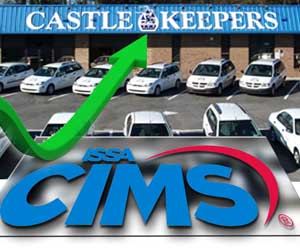When you reach the ever-elusive $1M/year revenue goal, continuing to grow and get better requires digging down into the details of your business to motivate continuous growth and improvement.
Castle Keepers, Inc. will be undergoing its third CIMS-GB review and renewal next month. CIMS and CIMS-GB stand for Cleaning Industry Management Standard, and the GB addition stands for Green Building. Other cleaning business owners often ask us why we would spend the time and money to get a CIMS certification for our relatively small cleaning company, because in residential and light commercial cleaning we don’t really use CIMS to gain cleaning contracts and ongoing jobs. Unlike some contract cleaning companies who gain certification to be eligible to bid on lucrative contracts that require CIMS certification, most of our clients don’t really know or care about the CIMS standard. For many reasons, however, we consider it an excellent investment in our company.
According to ISSA, CIMS is “the first consensus-based management standard that outlines the primary characteristics of a successful, quality cleaning organization.” The CIMS standard is based upon examples designed by and for other industries to create a system of continuous actions that lead to measureable improvements in businesses processes and services. Said another way, CIMS certification demonstrates that an organization which provides cleaning services is fully prepared to deliver quality, customer-focused services. CIMS also ensures the organization is capable of providing a comprehensive green cleaning program based on LEED: EB O&M green-cleaning criteria.
But on a much smaller, day-to-day scale, for us our CIMS certification is a byproduct of going through the CIMS process step-by-step, rather than the main goal. The real benefit for our business is using the CIMS framework to constantly improve our business in the following ways:
· To significantly improve the performance of our business, in increased efficiency, productivity, and quality of our services, with measureable criteria. A good example of this is found in our revision of our Human Resources policy. We had many processes and procedures for hiring and training, but when we sat down to review and organize the process that no one liked doing and fill in any gaps, we discovered some inefficiencies and redundancies. By thoughtfully evaluating the recruitment, selection, hiring, orientation/training, retention and timekeeping/payroll process, and putting some thought into what parts of this process were most valuable to measure to determine success, we made an ungainly and disorganized process into a more streamlined, effective operation which is more pleasant for everyone involved. We were able to upgrade the quality of our workforce and retention improved.
· To create goals and processes to positively drive growth, cut costs and increase profits. By creating financial controls and standardization over the procurement process, we are alerted to budget problems early and can institute a plan of action to correct them.
· To identify ways to effectively communicate with our customers and give our business a competitive edge. We have a diverse client base and discovered through surveys they have varied communication preferences. Some prefer email, some want to be called on the phone, and some request a text. We developed procedures to take advantage of their communication preferences.
· To enhance our credibility and secure the confidence of our clients. By far the most abstract and difficult part of CIMS process for us was creating our Quality Plan. Once the conceptual stuff was done, it was easier to develop significant measurement techniques to ensure we met scope of work and performance outcome requirements. We did this by creating meaningful customer surveys, updating our inspection procedure, revamping our customer complaint procedure and providing ways for customers to perform their own inspections and report results to us.
· To develop a culture of quality and continuous improvement. With quality measurements based on concrete standards and non-threatening evaluations, all employees are held accountable for their work and behavior, and employees are more likely to take responsibility for their performance and actions.
· To organize training, procedures and evaluations to meet specific, measureable benchmarks of which all employees are mindful and for which they are accountable. Since we instituted CIMS, employees say they are more aware of what is expected of them.
· To help comply with federal, state and local regulations. Without CIMS, it is much easier to procrastinate updating those dratted DOL Labor Law posters that all businesses are required to update and post annually; we created a schedule for reviewing and updating such things. Another example is OSHA’s HazCom 2012 and the Globally Harmonized System of Classification and Labeling of Chemicals (GHS) which, among other things, requires the new Safety Data Sheets (SDSs) for all chemicals in use by a company and training on the use of these chemicals to be available to all employees. This might not have been on our radar until after it was supposed to be fully implemented, but since we have to update our CIMS manual every two years for recertification, we have kept up with the deadlines so we didn’t have to cram all changes in at once.
· To provide a blueprint for making our company greener and providing comprehensive green cleaning services for clients. We had some basic green cleaning functions in place, but had not thought beyond that because we didn’t know more could be done. CIMS-GB provided a comprehensive framework for us to follow to “green” aspects of our business and service we hadn’t thought of.
· To provide an opportunity to network with other CIMS organizations and experts, form a community and share ideas and experiences for problem-solving. It is inspirational and thought-provoking to hear from other CIMS companies how they solved problems to meet certain CIMS criteria. They provide a lot of “What a great idea! Why didn’t we think of that?” moments.
Yes, going through the CIMS process can be time-consuming and expensive, but it is based on best practices gleaned from years of experience in other industries and assiduously applied to our own. Managing your business on these principles is a calculable and reliable way to grow your business and ultimately receive an excellent return on your investment.
Here is a summary of similar quality programs developed by other industries that follow best-practice continuous improvement processes and create measureable benchmarks in order to track progress in all areas of business:
Doctors, nurses and other hospital workers are familiar with The Joint Commission. The Joint Commission accreditation and certification of hospitals and health care services is recognized nationwide as a symbol of quality that reflects an organization’s commitment to meeting certain recognized performance standards for patient care. It measures the health care facility’s ability to provide safe and effective care of the highest quality and value and impacts a facility’s ability to receive grants, funding, and reimbursement from insurance companies.
Manufacturers and engineers know all about the International Organization for Standardization (ISO), or the ISO 9000 core series standards. Collectively, the five international standards provide requirements, specifications, guidelines or characteristics that can be used consistently to ensure that materials, products, processes and services are fit for their purpose throughout the supply chain.
Many people in the cleaning industry have heard of LEED-USGBC, which stands for Leadership in Energy and Environmental Design – U.S. Green Building Council, which is a green building certification program that recognizes best-in-class building strategies and practices and has some building cleaning and maintenance standards building service contractors are required to follow if they service a LEED-USGBC certified building.
Of course, there is the Baldrige Performance Excellence Program, a public-private partnership dedicated to improving the competitiveness and performance of U.S. organizations. The National Institute of Standards and Technology (NIST, a non-regulatory agency of the U.S. Department of Commerce) and the American Society of Quality (ASQ, a professional, non-profit association) work together to identify best-in-class companies based on seven criteria: Leadership, Strategic Planning, Customer Focus, Measurement/Analysis/Knowledge Management, Workforce Focus, Process Management, and Results. Its highest award, the Malcolm Baldrige National Quality Award, is bestowed upon the winning company by the President of the United States.
The bottom line is these organizations help ensure that businesses following their criteria are high-performing, and that their products and services are safe, effective, reliable, of good quality, and help reduce negative impacts on the environment. In one way or another, they also help organizations look for ways to optimize their operations and improve cost savings, improve quality, enhance customer satisfaction, increase sales, access new markets, and increase productivity and competitive advantage.
Janice Stewart is the owner of Castle Keepers of Charleston and driving force behind the development of the Modern Cleaning approach, Janice brings her scientific and healthcare background to inform the development of effective, safe, and healthy cleaning methods.






